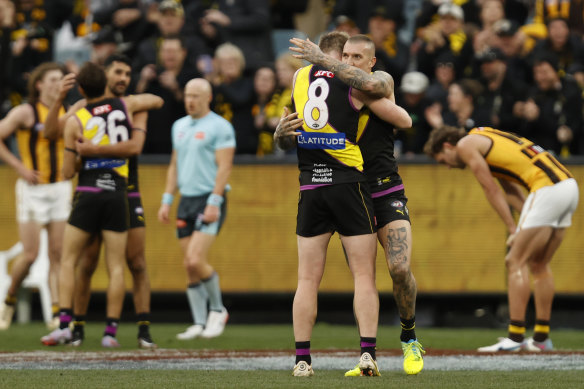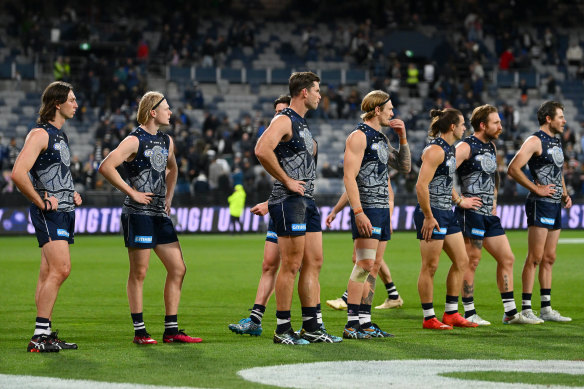Opinion
Full-time footy is a myth, and it shows on the scoreboard
Kane Cornes
AFL columnistOf all the inspirational quotes plastered on images in club locker rooms, one has gone missing from the walls of every AFL club gym: “If you only give 90 per cent in training, then you will only give 90 per cent when it matters.”
One of the greatest fallacies of the AFL professional era, that put players on full-time salaries from the mid-1990s, is that full-time wages would equal full-time training hours and, in turn, an increase in skill and performance.

Jack Riewoldt and Dustin Martin celebrate Richmond’s big comeback victory over Hawthorn in round 19.Credit: Getty Images
And that we, as fans, would see better games.
Today, AFL players are collecting an average annual salary of more than $400,000.
It is the sort of money that should have them 100 per cent focused on their job – as footballers. But a close look at their working hours and holidays reveals they spend more time in other fields than on the training track.
So much for that well-known mantra “practice makes perfect”. Why are AFL players not spending more of their week fine-tuning skills, building their bodies, recovering, perfecting goal-kicking routines and studying the game plan?
The work-life balance has gone too far; clubs give their players too much time off. It is starting to show on the scoreboard, and in the games we watch weekly.
Hawthorn played their final home-and-away game on August 20 last season. Players with five or more years of experience were not required to return to pre-season training until December 5.
Where else would any professional get a 15-week off-season holiday? In the league’s collective bargaining agreement, AFL players also receive an additional break for a few weeks across Christmas, plus three mandatory four-day rest periods during the season.
The clubs also must give the players at least one full day off each week. It is a dream job, but the results on the field are far from dreamy.

Richmond’s Liam Baker celebrates his matchwinning goal over the Hawks in round 19.Credit: Getty Images
Hawthorn coach Sam Mitchell rang the alarm bells with some telling admissions after his team coughed up a 36-point lead against Richmond in round 19.
“We haven’t done a lot of scenario training, two goals up, two goals down, 10 minutes to go. We haven’t done a lot of that training because being in games has been a big challenge for us across the course of the year,” Mitchell said.
Some of that 15-week break should have been spent working on “red time” strategies to prepare the players for crucial late game moments.
Hawthorn have lost three games by three points or fewer this season. How many of these results could have been different with more done on the training track?

The Cats react after the loss to the Giants, one of five games decided by fewer than two goals for Geelong this season.Credit: AFL Photos
It is not just young, rebuilding teams like Hawthorn that would like to answer this question by working harder during the week.
Geelong have had five games decided by fewer than two goals this season. The AFL premiers lost four and drew one. They are now ninth but would be second to Collingwood with five extra wins.
Even a seasoned group such as Geelong must still hit the classroom and training track to hone their strategy in close games. To do so, coach Chris Scott needs access to his players.
Scott and former captain Joel Selwood have created a relaxed football program at Geelong that allows the players to complete a large chunk of their training and recovery in their own time.
In the first two days after most games, players can report to the club for rehab when it suits them, allowing captain Patrick Dangerfield and his teammates to spend time with family or participate in activities outside of football. Geelong defender Jed Bews lauds this flexibility, saying it makes the footy club “an awesome place to work”.
Before last year’s grand final, Geelong football boss Simon Lloyd was at ease with this program “because everyone lives close to [GMHBA Stadium], you will often find that players will come in and do their own recovery and things like that. That is the type of program we run.
“We’re a big one on making sure that the players tailor their own programs to their own needs,” Lloyd added.
Geelong have last year’s flag – and a great win-loss record – to say this strategy has worked. Not only has it led to on-field success, but the method has also been a critical recruiting aid for attracting new players to Geelong.
But what if this has now gone too far? The lack of training appears to have caught up with the napping Cats. Geelong have left the impression of a scratchy and unorganised team this season. They lack the hardness and sharp skills of a well-drilled unit.
The once-feared midfield continues to be exposed. Soft-tissue injuries to star players Tom Hawkins and Mark Blicavs indicate a lack of conditioning.
Geelong’s success has led to the copycat theme at rival clubs trying to adopt a similar regime. Earlier this season, new St Kilda coach Ross Lyon revealed his players are only required to train for 15 hours a week, including weights sessions and recovery activities such as massage.
Full-time athletes who get about 20 weeks annually, plus just 15 hours of work each week. Sounds too good to be true.
Compare this to the time commitment of elite athletes in other sports. Rafael Nadal, the 22-time grand slam tennis champion, never went more than two days in any year without hitting a tennis ball, let alone 15 weeks. The same applies to the world’s best golfers.
Australia’s best marathon runners train every day, all year. They run twice a day, most days, and cover between 150-200 kilometres each week. Some of these athletes also work day jobs to earn a wage to pay their bills.
Quarterback, the Netflix documentary, follows three NFL quarterbacks – including Super Bowl MVP Patrick Mahomes – during the 2022 season. The Kansas City superstar tells how he employs a personal trainer to put him through a rigorous program with three weekly sessions that add to the club’s program for the weekend game.
With a month to play in the home-and-away season, just two wins separate St Kilda in fifth position and Gold Coast at 14th.
Imagine how an extra hour or two on the training track each week might have helped some clubs sit on higher perches on the AFL ladder. The harder you work …
Keep up to date with the best AFL coverage in the country. Sign up for the Real Footy newsletter.